|
|
|
|
|
Oil On
Canvas, Real Flavor of Old Masters
|
|

|
ARTWORKS
INDEX
A B C D E F G H I J K L M N O P Q R S T U V W X Y Z |
ARTISTS
INDEX
A B C D E F G H I J K L M N O P Q R S T U V W X Y Z |
|
|
| | |
|
|
 |
Adriaen van de Venne -- Click Here
|
|
Delft 1589-The Hague 1662
Dutch painter, draughtsman and poet. De Bie's account (1661) is the only known source on van de Venne's youth and training. He was born of 'worthy' parents who had fled to Delft from the southern Netherlands to escape war and religious strife. Inspired by his early study of Latin to become an illustrator, he was partly self-taught but also received instruction in painting and illumination from the otherwise unrecorded Leiden goldsmith and painter Simon de Valck. His second teacher, Hieronymus van Diest, |
|
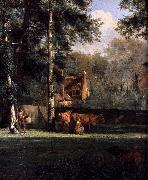 |
Adriaen van de Velde -- Click Here
|
|
(bapt. 30 November 1636, Amsterdam - bur. 21 January 1672, Amsterdam), was a Dutch animal and landscape painter, son of Willem van de Velde the Elder and brother of Willem van de Velde the Younger, the marine painter.
Adriaen did not want to become a marine painter so he was trained in the studio of Jan Wynants, the landscape painter. There he made the acquaintance of Philip Wouwerman, who is believed to have aided him in his studies of animals, and to have exercised a powerful and beneficial influence upon his art. Having made exceptionally rapid progress, he was soon employed by his master to introduce figures into his landscape compositions, and he rendered a similar service to Hobbema, Ruysdael, Verboom and other contemporary artists. According to Houbraken, he died while in collaboration with Jan van der Heyden and Frederik de Moucheron, painting animals on their paintings.[1]
His favourite subjects were scenes of open pasture land, with sheep, cattle and goats, which he executed with dexterity, with much precision of touch and truth of draughtsmanship, and with clear silvery colouring. He painted a few small winter scenes with skaters, and several religious subjects, such as the Descent from the Cross, for a Roman Catholic hidden church in Amsterdam.
In addition to his paintings, of which nearly two hundred have been catalogued, he executed about twenty etchings, several of which appear from their dates to have been done in his fourteenth year. They are distinguished by directness of method and by delicacy and certainty of touch. Van de Velde lived in Kalverstraat, near the Regulierspoort.
|
|
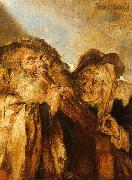 |
Adriaen Pietersz Vande Venne -- Click Here
|
|
Dutch
1589-1662
|
|
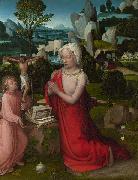 |
Adriaen Isenbrant -- Click Here
|
|
(between 1480 and 1490 - Bruges, July 1551), was a Flemish Northern Renaissance painter, who from documentary evidence was clearly a significant artist of his period, but to whom no specific works can be clearly documented. As hypothesised by art historians, he ran a large workshop specializing in religious subjects and devotional paintings, painting conservatively in the tradition of Early Netherlandish painting. He is believed by some to be the anonymous Master of the Seven Sorrows of the Virgin. Other art historians doubt that any works can be reliably attributed to him, and the number of paintings attributed to him by major museums has been in decline for many decades.
There are only a few documentary records of his life, and some mentions in literature from his lifetime or soon after, but he cannot be documented as the creator of any surviving work; everything else consists of hypothesis. It is possible that he was born in Haarlem or even in Antwerp about 1490. It is not known where or with which painter he served his apprenticeship.
He is named for the first time in 1510, when he came to Bruges and bought his burghership. In November of the same year he already became master in the painterse Guild of St. Luke and the goldsmithse guild of St. Elooi. He was later elected nine time a deacon (in Old Dutch : vinder) and twice the governor (in Old Dutch : gouverneur = treasurer) of the guild.
Soon he had an important workshop, probably in the Korte Vlaminckstraat in Bruges. This was close to the workshop of Gerard David, at the Vlamijncbrugghe and the former workshop of Hans Memling. Bruges, at that time, was one of the richest towns in Europe. Rich traders and merchants ordered diptychs and portraits for personal use. Isenbrandt painted mainly for private clients. However, there were some paintings that were created without any particular commission. He had enough work to even put out work to other painters in Bruges, as a legal suit from 1534 by Isenbrandt against Jan van Eyck (not the famous one) for non-delivery of paintings he had ordered, demonstrates. He was also appointed the agent in Bruges of the painter Adriaan Provoost (son of Jan Provoost), who had moved to Antwerp in 1530. Contemporary sources therefore mention Isenbrandt as a famous and well-to-do painter.
He married twice, the first time with Maria Grandeel, daughter of the painter Peter Grandeel. They had one child. After her death in 1537, he married again in 1547 with Clementine de Haerne. This second marriage resulted in two daughters and a son. He also had an extramarital daughter with the innkeeper Katelijne van Brandenburch (who was at the same the mistress of his friend Ambrosius Benson).
When he died in 1551, he was buried alongside his first wife at the cemetery of the St. Jacob church in Bruges; his children inherited no less than four houses with surrounding property.
|
|
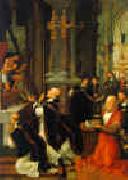 |
Adriaen Isenbrandt -- Click Here
|
|
Flemish Northern Renaissance Painter, ca.1500-1551
There are only a few documentary records of his life, and some mentions in literature from his lifetime or soon after, but he cannot be documented as the creator of any surviving work; everything else consists of hypothesis. It is possible that he was born in Haarlem or even in Antwerp about 1490. It is not known where or with which painter he served his apprenticeship.
He is named for the first time in 1510, when he came to Bruges and bought his burghership. In November of the same year he already became master in the painters?? Guild of St. Luke and the goldsmiths?? guild of St. Elooi. He was later elected nine time a deacon and twice the governor of the guild.
Soon he had an important workshop, probably in the Korte Vlaminckstraat in Bruges. This was close to the workshop of Gerard David, at the Vlamijncbrugghe and the former workshop of Hans Memling. Bruges, at that time, was one of the richest towns in Europe. Rich traders and merchants ordered diptychs and portraits for personal use. Isenbrandt painted mainly for private clients. However, there were some paintings that were created without any particular commission. He had enough work to even put out work to other painters in Bruges, as a legal suit from 1534 by Isenbrandt against Jan van Eyck (not the famous one) for non-delivery of paintings he had ordered, demonstrates. He was also appointed the agent in Bruges of the painter Adriaan Provoost (son of Jan Provoost), who had moved to Antwerp in 1530. Contemporary sources therefore mention Isenbrandt as a famous and well-to-do painter.
He married twice, the first time with Maria Grandeel, daughter of the painter Peter Grandeel. They had one child. After her death in 1537, he married again in 1547 with Clementine de Haerne. This second marriage resulted in two daughters and a son. He also had an extramarital daughter with the innkeeper Katelijne van Brandenburch (who was at the same the mistress of his friend Ambrosius Benson).
When he died in 1551, he was buried alongside his first wife at the cemetery of the St. Jacob church in Bruges; his children inherited no less than four houses with surrounding property. |
|
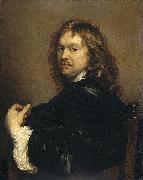 |
Adriaen Hanneman -- Click Here
|
|
(c. 1603 - buried 11 July 1671) was a Dutch Golden Age painter best-known today for his portraits of the exiled British royal court. His style was strongly influenced by his contemporary, Anthony Van Dyck.
|
|
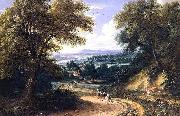 |
Adriaen Frans Boudewijns -- Click Here
|
|
Adriaan Frans Boudewyns, not Anton Frans (Bauduins, or Baudouin), (3 October 1644 - 3 December 1719) was a Flemish Baroque landscape painter.
He was born at Brussels and learned to paint under a landscape painter named Ignatius van der Stock, and was received into the Guild there in 1665. He then travelled to Paris in 1666 and studied under A. F. van der Meulen for three years, and whose daughter Barbara he married 12 January 1670. In 1674 his wife died and in 1681 he moved back to Brussels where he married again. According to Houbraken he was a good landscape painter who encourage Gerard Hoet to stay in Brussels for 8 months in the 1680s. His son Frans Boudewijns (1682-1767) also became a successful painter. He was ruined in the bombardment of Brussels in 1695.
Adriaen Fransz. Boudewijns, Adriaen Frans Boudewyns, Adriaen Frans Baudewijns, Adriaen Frans Baudewyns, Anton Frans Baudouin, Adriaen Frans Bauduins, Adrien François Bauduins, Monogrammist AFB |
|
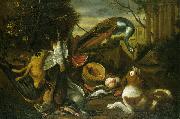 |
Adriaen de Gryef -- Click Here
|
|
Belgium (1670-1715 ) - Painter |
|
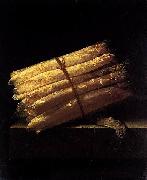 |
Adriaen Coorte -- Click Here
|
|
(ca. 1665 - after 1707) was a Dutch Golden Age painter of still lifes, who signed works between 1683 and 1707. He painted small and unpretentious still lifes in a style more typical of the first half of the century, and was "one of the last practitioners of this intimate category".
Very little is known of his life, but he is assumed to have been born and died in Middelburg. He became a pupil of Melchior d'Hondecoeter around 1680 in Amsterdam. From 1683 he seems to have returned to Middelburg, where he set up a workshop and signed his small, carefully balanced minimalist still lifes. He often painted on paper that was glued to a wooden panel. About 80 signed works by him have been catalogued, and nearly all of them follow the same pattern; small arrangements of fruits, vegetables, or shells on a stone slab, lit from above, with the dark background typical of still lifes earlier in the century. Instead of the Chinese or silver vessels favoured by his contemporaries, his tableware is very basic pottery. "Objects and light are studied intensely, and are painted with a wondrous tenderness".[1] Neither his birth nor death date is certain, and archival evidence only exists in Middelburg for his membership in the Guild of St. Luke there from 1695 onwards, when he was fined for selling a painting without being a member of the guild. His works appear frequently in contemporary Middelburg taxation inventories |
|
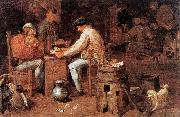 |
Adriaen Brouwer -- Click Here
|
|
(1605 - January 1638) was a Flemish genre painter active in Flanders and the Dutch Republic in the seventeenth century.
At a young age Brouwer, probably born as Adriaen de Brauwer in Oudenaarde, moved perhaps via Antwerp to Haarlem, where he became a student of Frans Hals alongside Adriaen van Ostade. He also was active in stage acting and poetry. He stayed in Haarlem and Amsterdam until 1631, when he moved back to Antwerp in the Spanish Netherlands. There, he became a member of the Guild of St. Luke in 1631-1632, as well as the rhetoricians's chamber De Violieren.
Tradition has it that Brouwer himself spent much time in the alehouses of Flanders and Holland. His works are typically detailed and small, and often adopt themes of debauchery, drunkenness and foolishness in order to explore human emotions, expressions and responses to pain, fear and the senses. The Bitter Tonic is an example of the type of work that depicts such responses, in this case the sense of taste. His work was well liked, to the point that forgeries were sold in his own time. Both Rubens and Rembrandt owned a number of his works. Nevertheless, Brouwer appeared in financial trouble throughout his life.
He died at the early age of 32 in Antwerp, where he was first buried in a common grave. |
|
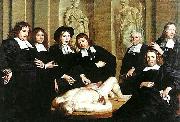 |
adriaen backer -- Click Here
|
|
the anatomy lesson of dr frederick ruysch,
1670. amsterdams historisch museum |
|
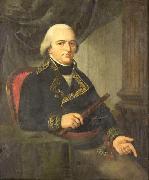 |
Adriaan de Lelie -- Click Here
|
|
was born at Tilburg in 1755, and was a scholar of Peeters, a painter of tapestries and ornaments, and afterwards of Quertenmont at Antwerp. He made copies of many of the portraits by Rubens and Van Dyck at Desseldorf, and also of historical pictures by Italian and Dutch masters. By the advice of Professor Camper, he established himself at Amsterdam, where he painted a great number of portraits and cabinet pictures; among the latter is one of the celebrated amateur Jan Gildemeester showing his collection to a party of ladies and gentlemen, in which the principal pictures are readily recognised. One of his best works is that representing the 'Drawing Academy' of the Felix Meritis Society at Amsterdam. His pictures are highly esteemed in Holland and Germany, where they are to be met with in the best collections. He died at Amsterdam in 1820.
|
|
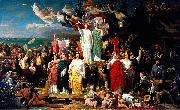 |
Adolphe Yvon -- Click Here
|
|
Adolphe Yvon (1817-1893) was a French painter known for his paintings from the Napoleonic Wars. Yvon studied under Paul Delaroche, rose to fame during the Second Empire, then finished his career as a teacher.
Shortly after the end of the Crimean War in September 1855, Yvon was commissioned by the French government to paint a large picture of the capture of the Malakoff at Sevastopol. He sailed for the Crimea on February 19, 1856 where he spent six weeks compiling a portfolio of sketches, as well as visiting the battlefield of Inkerman. In 1857, the finished painting La Prise de la tour de Malakoff 8 septembre 1855 was shown at the Paris Salon, and two years later came La Gorge de Malakoff, and La courtine de Malakoff. La Prise was a massive piece measuring 6 metres by 9 metres and represented the moment when the fortification was captured around midday.
In the succeeding years, Emperor Napoleon III began to admire his battle scenes; naturally he glorified the carnage of Napoleon I's campaigns. Yvon became an officer of the Legion d'Honneur in 1867, and painted Napoleon III's portrait the following year (unlocated). Yvon was known as the leading teacher of drawing at the Ecole des Beaux-Arts (1863-83). A few Americans received instruction from him, including Christian Schussele, Alfred Wordsworth Thompson, William Sartain, and J. Alden Weir. The latter took Yvon's afternoon life-drawing class starting in the fall of 1874. Yvon provided the subject for compositional sketches for his students, for example, The Assassination of Julius Caesar, for which he specified how it should be done: Caesar covers his head with his toga. |
|
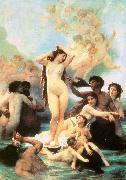 |
Adolphe William Bouguereau -- Click Here
|
|
Bouguereau made more than seven hundred finished works. French painter. From 1838 to 1841 he took drawing lessons from Louis Sage, a pupil of Ingres, while attending the coll?ge at Pons. In 1841 the family moved to Bordeaux where in 1842 his father allowed him to attend the Ecole Municipale de Dessin et de Peinture part-time, under Jean-Paul Alaux. In 1844 he won the first prize for figure painting, which confirmed his desire to become a painter. As there were insufficient family funds to send him straight to Paris he painted portraits of the local gentry from 1845 to 1846 to earn money. In 1846 he enrolled at the Ecole des Beaux-Arts, Paris, in the studio of Francois-Edouard Picot. This was the beginning of the standard academic training of which he became so ardent a defender later in life. Such early works as Equality reveal the technical proficiency he had attained even while still training. In 1850 he was awarded one of the two Premier Grand Prix de Rome for Zenobia Discovered by Shepherds on the Bank of the River Araxes (1850; Paris, Ecole N. Sup. B.-A.). In December 1850 he left for Rome where he remained at the Villa Medici until 1854, working under Victor Schnetz and Jean Alaux (1786-1864). During this period he made an extensive study of Giotto's work at Assisi and Padua and was also impressed by the works of other Renaissance masters and by Classical art. On his return to France he exhibited the Triumph of the Martyr (1853; Luneville, Mus. Luneville; ) at the Salon of 1854. It depicted St Cecilia's body being carried to the catacombs, and its high finish, restrained colour and classical poses were to be constant features of his painting thereafter. All his works were executed in several stages involving an initial oil sketch followed by numerous pencil drawings taken from life. Though he generally restricted himself to classical, religious and genre subjects, he was commissioned by the state to paint Napoleon III Visiting the Flood Victims of Tarascon in 1856 |
|
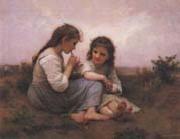 |
Adolphe Bouguereau -- Click Here
|
|
French
1825-1905
French painter. From 1838 to 1841 he took drawing lessons from Louis Sage, a pupil of Ingres, while attending the coll?ge at Pons. In 1841 the family moved to Bordeaux where in 1842 his father allowed him to attend the Ecole Municipale de Dessin et de Peinture part-time, under Jean-Paul Alaux. In 1844 he won the first prize for figure painting, which confirmed his desire to become a painter. As there were insufficient family funds to send him straight to Paris he painted portraits of the local gentry from 1845 to 1846 to earn money. In 1846 he enrolled at the Ecole des Beaux-Arts, Paris, in the studio of Fran?ois-Edouard Picot. This was the beginning of the standard academic training of which he became so ardent a defender later in life. Such early works as Equality (1848; priv. col., see 1984-5 exh. cat., p. 141) reveal the technical proficiency he had attained even while still training. In 1850 he was awarded one of the two Premier Grand Prix de Rome for Zenobia Discovered by Shepherds on the Bank of the River Araxes (1850; Paris, Ecole N. Sup. B.-A.). In December 1850 he left for Rome where he remained at the Villa Medici until 1854, working under Victor Schnetz and Jean Alaux (1786-1864). During this period he made an extensive study of Giotto's work at Assisi and Padua and was also impressed by the works of other Renaissance masters and by Classical art. On his return to France he exhibited the Triumph of the Martyr (1853; Lun?ville, Mus. Lun?ville; see fig. 1) at the Salon of 1854. It depicted St Cecilia's body being carried to the catacombs, and its high finish, restrained colour and classical poses were to be constant features of his painting thereafter. All his works were executed in several stages involving an initial oil sketch followed by numerous pencil drawings taken from life. |
|
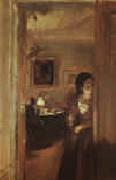 |
Adolph von Menzel -- Click Here
|
|
1815-1905
German
Adolph von Menzel Gallery
His father was the headmaster of a school for girls, and intended to educate his son as a professor; but he would not thwart his taste for art. Left an orphan in 1832, Menzel had to maintain his family. In 1833 Sachse of Berlin published his first work, an album of pen-and-ink drawings reproduced on stone, to illustrate Goethe's little poem, Kunstlers Erdenwallen. He executed lithographs in the same manner to illustrate Denkw??rdigkeiten aus der brandenburgisch-preussischen Geschichte; The Five Senses and The Prayer, as well as diplomas for various corporations and societies.
From 1839 to 1842 he produced 400 drawings, largely introducing to Germany the technique of wood engraving, to illustrate the Geschichte Friedrichs des Grossen (History of Frederick the Great) by Franz Kugler. He subsequently brought out Friedrichs der Grossen Armee in ihrer Uniformirung (The Uniforms of the Army under Frederick the Great), Soldaten Friedrichs der Grossen (The Soldiers of Frederick the Great); and finally, by order of the king Frederick William IV, he illustrated the works of Frederick the Great, Illustrationen zu den Werken Friedricks des Grossen (1843-1849).
By these works Menzel established his claim to be considered one of the first, if not actually the first, of the illustrators of his day in his own line.
Pencil drawing by Menzel, 1891.Meanwhile Menzel had set himself to study unaided the art of painting, and he soon produced a great number and variety of pictures, always showing keen observation and honest workmanship in subjects dealing with the life and achievements of Frederick the Great, and scenes of everyday life, such as In the Tuileries, The Ball Supper, and At Confession. Among the most important of these works are The Forge (1875) and The Market-place at Verona. Invited to paint The Coronation of William I at Koenigsberg, he produced an exact representation of the ceremony without regard to the traditions of official painting.
In Germany he received many honors, and was the first painter to be given the Order of the Black Eagle in 1898 which included a title of nobility, becoming von Menzel. |
|
|
|
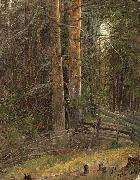 |
Adolph Tidemand -- Click Here
|
|
(1814-1876) was a noted Norwegian romantic nationalism painter. Among his best known paintings are Haugianerne (The Haugeans painted in 1852) and Brudeferd i Hardanger (The Bridal Procession in Hardanger painted in 1848) with Hans Gude.
Adolph Tidemand was born in Mandal, Norway as the son of customs inspector and Storting representative Christen Tidemand (1779-1838) and Johanne Henriette Henrikke Haste (1779-1859). He received private art lessons in his home town and his talent was soon recognized. He then was enrolled in an art school in Christiania, moving on to Copenhagen in the period 1832-37. Upon arrival in Copenhagen, he was rejected by the Royal Danish Academy of Fine Arts and studied at a private school of art, but by 1833 he was a pupil at the Academy, earning Academy exhibitions in 1835 and 1836. He studied there for five years and then began a journey to Italy to study further. But when Tidemand came to Desseldorf, Germany, he liked it so much that he settled down there.
From 1837-1841 he continued his studies with the art academy in Desseldorf, which at the time enjoyed widespread international recognition. He studied with and was influenced by his teacher, Theodor Hildebrandt. |
|
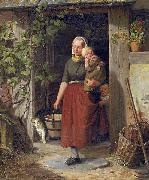 |
Adolph Heinrich Richter -- Click Here
|
|
painted A young wine grower and her children in |
|
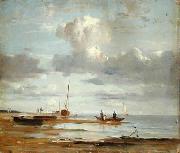 |
Adolph Friedrich Vollmer -- Click Here
|
|
(17 December 1806 - 12 February 1875) was a German landscape and marine painter and graphic artist. He and his contemporary, the painter Christian Morgenstern, were pioneers in Hamburg of early Realism in painting.
As son of a bookkeeper to a Hamburg merchant, Vollmer grew up in humble circumstances.[3] Determined to become a painter against the wishes of his father,[4] he became an apprentice to the brothers Suhr who owned a graphic workshop producing panorama prints. For one and a half years Vollmer travelled throughout Germany with one of the brothers, Cornelius Suhr, as had been Morgenstern before him. In 1826 he was introduced by the Hamburg art-dealer Ernst Harzen to the wealthy aristocrat and supporter of the arts, Carl Friedrich von Rumohr, who was patron to many young Hamburg artists among them Morgenstern and Otto Speckter. Probably on Rumohr advice Vollmer completed his studies under Christoffer Wilhelm Eckersberg at the Royal Danish Academy of Fine Arts in Copenhagen. He then moved to Munich from where he undertook journeys to Lake Konstanz, to the Austrian and Swiss Alps, to Venice, to Le Havre and to the Netherlands.
In 1839 Vollmer returned to Hamburg and settled there. One of his sons, Johannes Vollmer, became a prominent architect of protestant churches; a grand-son was the art historian and encyclopaedist Hans Vollmer who, for many years, edited the Thieme-Becker Kenstler Lexikon.
Vollmer became blind in 1866.
|
|
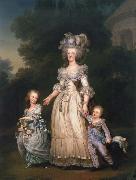 |
Adolf-Ulrik Wertmuller -- Click Here
|
|
Swedish Painter, 1751-1811,was a Swedish painter whose notable works include Danaë receiving Jupiter in a Shower of Gold. Wertmuller was born in Stockholm and studied art at home before moving to Paris in 1772 to study under his cousin Alexander Roslin and French painter Joseph-Marie Vien. On July 30, 1784, Wertmuller was elected to the Royal Academy of Painting and Sculpture. Wertmuller was commissioned by Gustav III of Sweden for a portrait of Marie Antoinette, which is now in the Nationalmuseum at Stockholm. In 1787, he produced his masterpiece Danae, a work which proved controversial as one of the earliest female nude paintings exhibited in America. Wertmuller first emigrated to the United States in May 1794 and continued his portrait work, most notably of General Washington, but in 1796 was called back to Sweden, eventually returning to Philadelphia in 1800. Wertmuller was married to Elizabeth Henderson, granddaughter of noted early American painter Gustavus Hesselius, on January 8, 1801, and two years later retired to a plantation in Claymont, Delaware, where he lived the final years of his life. |
|
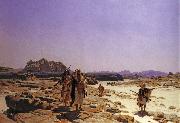 |
Adolf Von Meckel -- Click Here
|
|
German, 1856 - 1893 |
|
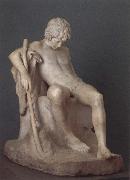 |
Adolf von Hildebrand -- Click Here
|
|
1847 Marburg-1921 Munich, He was a sculptor, the son of Marburg economics professor Bruno Hildebrand. He was the author of Das Problem der Form in der Bildenden Kunst ("The Problem of Form in Painting and Sculpture"). From 1873 he lived in Florence in San Francesco, a secularized sixteenth-century monastery. In 1877 he married Irene Schäuffelen. He spent significant time in Munich after 1889 executing a monumental fountain there, the Wittelsbacher Brunnen. He is known for five monumental urban fountains. He was ennobled by the King of Bavaria in 1904, He was the father of the painter Eva, Elizabeth, sculptor Irene Georgii-Hildebrand, Sylvie, Bertele, and Catholic theologian Dietrich von Hildebrand. |
|
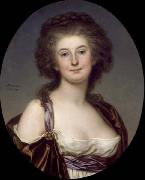 |
Adolf Ulrik Wertmuller -- Click Here
|
|
(February 18, 1751 e October 5, 1811) was a Swedish painter whose notable works include Danaë receiving Jupiter in a Shower of Gold.
Wertmeller was born in Stockholm and studied art at home before moving to Paris in 1772 to study under his cousin Alexander Roslin and French painter Joseph-Marie Vien. On July 30, 1784, Wertmeller was elected to the Royal Academy of Painting and Sculpture.
Wertmeller was commissioned by Gustav III of Sweden for a portrait of Marie Antoinette, which is now in the Nationalmuseum at Stockholm. In 1787, he produced his masterpiece Danaë, a work which proved controversial as one of the earliest female nude paintings exhibited in America.
Wertmeller first emigrated to the United States in May 1794 and continued his portrait work, most notably of General George Washington, but in 1796 was called back to Sweden, eventually returning to Philadelphia in 1800. Elizabeth B. Johnston, in her book Original Portraits of Washington (Boston, 1882), speaks of five portraits of Washington by Wertmeller, of which one, executed in 1797, was purchased by the U. S. government in 1878, and another is owned by the Historical Society of Pennsylvania.
Wertmeller was married to Elizabeth Henderson, granddaughter of noted early American painter Gustavus Hesselius, on January 8, 1801, and two years later retired to a plantation in Claymont, Delaware, where he lived the final years of his life. He died near Marcus Hook, Pennsylvania, aged 60.
|
|
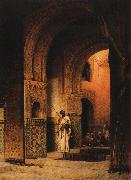 |
Adolf Steel -- Click Here
|
|
German, 1829 - 1907
German and lived in Germany.
Most of his works are about arab people and arabic street and city. There are a lot of oil paintings which are collected by museums in Europe. |
|
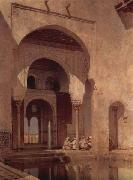 |
Adolf Seel -- Click Here
|
|
(1 March 1829-14 February 1907) was a German painter. He enjoyed training at the Dseldorf Academy of Arts.
Seel visited the academy in Dseldorf in 1844-50, where he trained under Wilhelm Sohn. He then continued to train one year in Paris, spent 1864 and 1865 in Italy, 1870 and 1871 Spain, Portugal and the north coast of Africa as well as 1873 and 1874 the Orient, where he developed his preference for the architecture painting found rich food. Its pieces of architecture, particularly the Arab and Moorish buildings, are usually provided just as beautiful landscapes painted with a masterful perspective, lighting and coloring.
|
|
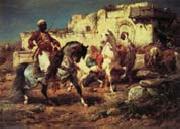 |
Adolf Schreyer -- Click Here
|
|
German Academic Painter, 1828-1899,German painter, was born at Frankfurt-am-Main. He studied art first at the Städel Institute in his native town, and then at Stuttgart and Munich. He painted many of his favourite subjects in his travels in the East. He first accompanied Prince Thurn and Taxis through Hungary, Wallachia, Russia and Turkey; then, in 1854, he followed the Austrian army across the Wallachian frontier. In 1856 he went to Egypt and Syria, and in 1861 to Algiers. In 1862 he settled in Paris, but returned to Germany in 1870; and settled at Cronberg near Frankfurt, where he died. Arab Horsemen by Schreyer.Schreyer was, and is still, especially esteemed as a painter of horses, of peasant life in Wallachia and Moldavia, and of battle incidents. His work is remarkable for its excellent equine draughtsmanship, and for the artist's power of observation and forceful statement; and has found particular favour among French and American collectors. Of his battle-pictures there are two at the Schwerin Gallery, and others in the collection of Count Mensdorff-Pouilly and in the Raven Gallery, Berlin. His painting of a Charge of Artillery of Imperial Guard was formerly at the Luxembourg Museum. The Metropolitan Museum, New York owns three of Schreyer's oriental paintings: Abandoned, Arabs on the March and Arabs making a detour; and many of his best pictures are in the Rockefeller family, Vanderbilt family, John Jacob Astor, William Backhouse Astor, Sr., August Belmont, and William Walters collections. |
|
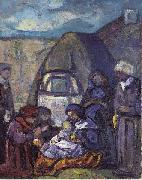 |
Adolf Holzel -- Click Here
|
|
(13 May 1853 - 17 October 1934) was a German artist/painter. His style developed from Impressionism to expressive modernism.
He was born in Olomouc in Moravia, the son of the publisher Eduard Hölzel. In 1871 his family moved to Vienna, and from 1872 he studied painting at the Vienna Academy. He continued his studies in Munich at the Kunstakademie beginning in 1876. There he became acquainted with the painter Fritz von Uhde and painted in a style influenced by Impressionism.
From 1888 to 1905 he worked in Dachau, where there was an artists' colony. Already during his time in Dachau his work began moving toward abstraction, reflecting his interest in such principles as the golden section and Goethe's Theory of Colors. He taught at the Stuttgart Academy, and paintedefour years before Wassily Kandinskyean abstract painting (Composition in Red, 1905). Among his students the so-called "Hölzel circle" developed, including Oskar Schlemmer, Willi Baumeister, Max Ackermann and Johannes Itten. In 1919 Adolf Hölzel left the Stuttgart Academy and went into retirement. He died in Stuttgart in 1934.
|
|
|
|
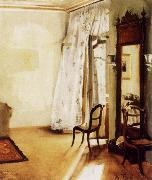 |
Adolf Friedrich Erdmann Menzel -- Click Here
|
|
1815-1905
Realism
German
|
|
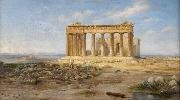 |
Adolf Bohm -- Click Here
|
|
Adolf Böhm
Austria (1861-1927 ) - Painter |
|
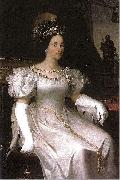 |
Adeodato Malatesta -- Click Here
|
|
Italy (1806 -1891 ) - Painter
|
|
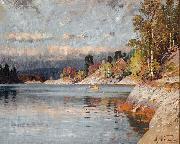 |
Adelsteen Normann -- Click Here
|
|
Adelsteen Normann (1 May 1848 - 26 December 1918) was a Norwegian painter who worked in Berlin. He was a noted painter of landscapes of Norway. Normann was the artist who invited Edvard Munch to Berlin, where he painted The Scream. Normann's fjord paintings are credited with making the Norwegian fjords a more popular tourist destination. |
|
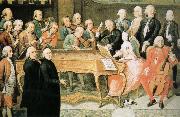 |
adelaide a procter -- Click Here
|
|
an English poet, was the eldest daughter of the poet Bryan Procter.
In 1851, Procter became a Roman Catholic. She took much interest in social questions affecting women. She wrote the well-known songs Cleansing Fires and The Lost Chord, and among her many hymns are I do not ask, O Lord, that Life may be, and My God, I thank Thee who hast made.
|
|
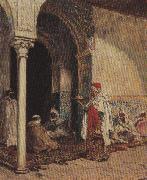 |
Addison T . Millar -- Click Here
|
|
American, 1860 - 1913 |
|
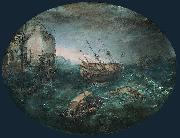 |
Adam Willaerts -- Click Here
|
|
(July 21, 1577, London - April 4, 1664, Utrecht ) was a Dutch Golden Age painter.
Willaerts (occasionally Willarts, Willers) was born in London to Flemish parents who had fled from Antwerp for religious reasons. By 1585 the family lived in Leiden. From 1597 until his death, Adam lived in Utrecht, where he became a member of the Guild of St. Luke in 1611, and subsequently rose to dean in 1620. His sons Cornelis, Abraham, and Isaac followed in his footsteps.
He was known as a painter of river and canal pieces, coastal landscapes, fish-markets, processions, and genre scenes. He also painted villages and marine battle scenes.
|
|
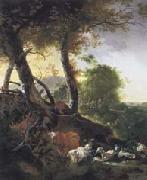 |
Adam Pynacker -- Click Here
|
|
Dutch Baroque Era Painter, 1622-1673 |
|
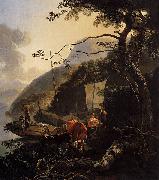 |
Adam Pijnacker -- Click Here
|
|
15 February 1622, Schiedam - buried 28 March 1673, Amsterdam ) was a Dutch Golden Age painter, mostly of landscapes.
Pynacker was the son of a wine merchant, who was a member of the vroedschap, or city regency. He travelled to Italy and was gone for three years. In 1658 he converted to Catholicism in order to marry Eva Maria de Geest, Wybrand de Geest's daughter. In that year his portrait was painted by his father-in-law. In Schiedam he baptized two children, but from 1661 until he died, he lived on the Rozengracht in Amsterdam.
|
|
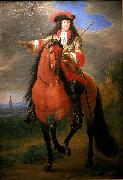 |
Adam Frans van der Meulen -- Click Here
|
|
painted Louis XIV before Strasbourg in 1682 |
|
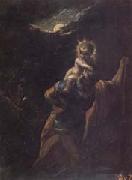 |
Adam Elsheimer -- Click Here
|
|
German Baroque Era Painter, 1578-1610
German painter, printmaker and draughtsman, active in Italy. His small paintings on copper established him after his brief life as the most singular and influential German artist to follow D?rer. Their grand conception in terms of monumental figures and poetic landscape and their meticulous, miniature-like execution were admired by Rubens and came to influence many 17th-century artists, including Rembrandt. |
|
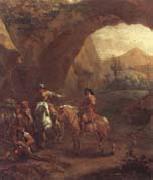 |
Adam Colonia -- Click Here
|
|
Dutch ,
Rotterdam 1634-1685 London
|
|
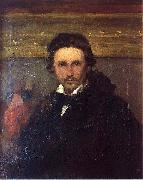 |
Adam Chmielowski -- Click Here
|
|
1845-1916) was a Polish religious brother and founder of the Albertines. He is a saint of the Catholic Church. Albert is also known as Brat Albert (Brother Albert); in recognition of his holiness he has also been called the "Brother of Our Lord", "Brother of Our God", and "Our God's Brother".
Adam Chmielowski was born to a wealthy aristocratic family, and initially studied agriculture with the intention of managing the family estate. Involved in politics since his youth, he lost a leg at the age of 17 while fighting in an insurrection. He became a well-known and well-liked artist in Krakew, his political convictions inspiring his interest in the human condition. A gentle and compassionate spirit, Chmielowski felt compelled to help those in need and after years of reflection, decided to follow his calling into the service of God.
In 1880, Chmielowski joined the Jesuits, took up the name Albert and abandoned painting. He began a life of service to the poor. In 1887, he founded the Brothers of the Third Order of Saint Francis, Servants of the Poor, known in honor of their founder as the Albertines or the Gray Brothers, after their rough gray habits. In 1891, he founded the women's congregation, the Gray Sisters. The Albertines organized food and shelter for the poor and homeless. |
|
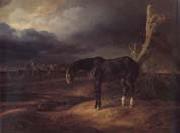 |
Adam Albrecht -- Click Here
|
|
1786-1862, was a German painter of battles and horses. Born in Nordlingen, he began an apprenticeship as a confectioner and went in 1803 to Nuremberg to begin his training. However, influenced by the director of the Academy of Fine Arts of Nuremberg and later by Johann Rugendas, he turned towards painting - mainly battlefields and horses. After participating in the Austrian campaign of 1809, he stayed for a time in Vienna, where he drew the attention of Napoleon's stepson Eug??ne de Beauharnais and was appointed his court painter. Most of Adam's subsequent works deal with Napoleon's Russian campaign, in which he participated under de Beauharnais. Among other works, he painted a diary of the campaign in 83 scenes. In 1815, Adam moved to Munich, where he was occupied by the emperors and kings of Bavaria and Austria. His studio in Munich was frequently visited by Theodor Horschelt, who later became well known for his paintings of Russian Caucasian War. He worked until a great age, recording battles and portraying horses, even though in his late works he was supported by the help of his sons, Benno, Eugen and Franz. He died in Munich. |
|
 |
Adam Elsheimer -- Click Here
|
|
1578-1610
German
Adam Elsheimer Locations
German painter, printmaker and draughtsman, active in Italy. His small paintings on copper established him after his brief life as the most singular and influential German artist to follow Derer. Their grand conception in terms of monumental figures and poetic landscape and their meticulous, miniature-like execution were admired by Rubens and came to influence many 17th-century artists, including Rembrandt. Most were produced in Rome after 1600: the limits of this oeuvre and its chronology are extremely hard to establish. |
|
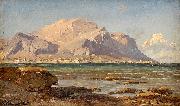 |
Adalbert Waagen -- Click Here
|
|
painted Bucht von Palermo mit Blick auf Monte Pellegrino in 1896 |
|
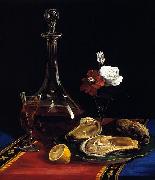 |
Adalbert John Volck -- Click Here
|
|
Adalbert J. Volck (1828 - 1912) was a dentist, political cartoonist, and caricaturist born in Bavaria. He was known for supporting the Confederacy during the American Civil War, doing so through his political cartoons (below), smuggling items for the Confederate army, and personally assisting President Jefferson Davis by acting as a courier.
Volck was also known for his work on porcelain restoration techniques in dentistry. |
|
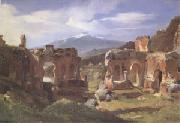 |
Achille-Etna Michallon -- Click Here
|
|
Paris 1796-1822
was a French painter. Michallon was the son of the sculptor Claude Michallon. He studied under Jacques-Louis David and Pierre-Henri de Valenciennes. In 1817, Michallon won the inaugural Prix de Rome for landscape painting. He travelled to Italy in 1818 and remained there for over two years. This trip had a profound influence on his work. Before he had much time to develop what he had learned however, he died at the age of 26 of pneumonia, a tragedy which cut short the life of a talented and well respected artist who could have gone on to win lasting fame. Though it is often disputed, it is thought that at one time, Corot was his pupil. |
|
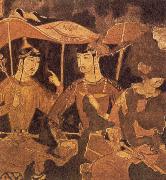 |
Abu l Faraj al Isfahani -- Click Here
|
|
Tenth century |
|
 |
abstract composition -- Click Here
|
|
Russian painter, sculptor, designer and photographer. He was a central exponent of Russian Constructivism, owing much to the pre-Revolutionary work of Malevich and Tatlin, and he was closely involved in the cultural debates and experiments that followed the Revolution of 1917. In 1921 he denounced, on ideological grounds, easel painting and fine art, and he became an exponent of Productivism (see CONSTRUCTIVISM,
|
|
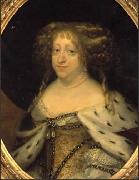 |
Abraham Wuchters -- Click Here
|
|
Abraham Wuchters (1608 - 23 May 1682) was a Dutch-Danish painter and engraver. He was born in Antwerp but had most of his career in Denmark where he, along with Karel van Mander III, was the preferred painter of the Danish King, nobility and Bourgeoisie during his day, together they represent the main influence from the Dutch Golden Age on Danish Baroque art.
Wuchters was born in Antwerp in 1608. He arrived in Denmark in 1638 and was, the following year, employed as sketching master at Sorø Academy. Around the same time, he was summoned to Copenhagen where he painted several portraits of King Christian IV. In 1645 he returned to Copenhagen Castle to portray the King's children, including lrik Christian Gyldenløve (c. 1645, Danish National Gallery) and Duke Frederik (III) (c. 1645, Amalienborg Palace).
In two periods, between 1658 and 1662, he worked at the Royal Swedish Court in Stockholm where he portrayed Queen Consort Christina (1660, Uppsala University and 1661, Stockholm Castle), Charles X Gustav and Hedvig Eleonora.
Back in Denmark, Wuchters was engaged by Frederick III, who had instituted Denmark as an absolute monarchy in 1660, with responsibility for the maintenance of his paintings.
n 1671 the new king, Christian V, appointed him as official Painter to the Danish Coirt and in 1873 he was also made official Engraver to the Danish Court. It was, therefore, he alone who decided how the face of the absolutist King was to be represented. |
|
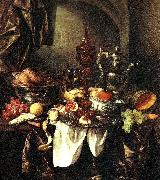 |
abraham vav beyeren -- Click Here
|
|
Abraham Hendriksz van Beijeren (ca. 1620 The Hague - March 1690 Rotterdam) was a Dutch Baroque era painter. He was little regarded in his day but is now considered one of the greatest of still-life painters. Van Beijeren (alternatively spelled "Beyeren") lived in a succession of Dutch towns. Born in The Hague, the artist also lived in Delft, Amsterdam, Alkmaar and Gouda. In 1678 he settled in Rotterdam, where he died in 1690.
|
|
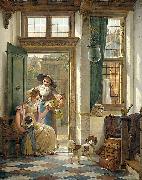 |
Abraham van Strij -- Click Here
|
|
painted Een kersenverkoopster aan de deur
in 1816 |
|
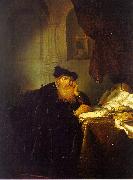 |
Abraham van der Hecken -- Click Here
|
|
Dutch Baroque Era Painter, active 1635-1655 |
|
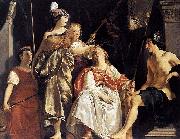 |
Abraham van den Tempel -- Click Here
|
|
(1622?C1672) was a Dutch Golden Age painter.
He probably learned painting from his father, also a painter, but who died when he was still quite young, in 1636. That is the same year that he moved to Amsterdam, where he stayed until 1647, whereupon he moved to Leiden. According to Houbraken he was the son of a Mennonite preacher in Leeuwarden who was a respected art teacher. His father was Lambert Jacobsz (or Jacobszoon), who had taught Govert Flinck and Jacob Adriaensz Backer in their youth, both of whom were artists from Mennonite families. Abraham took the name Tempel because when he studied in Leiden, he lived in a house there with a relief of a Tempel in the keystone. He became a pupil of Jacob Backer, and studied mathematics at Leiden University. He met with great success with the Leiden city council, earning several generous commissions, including a series of three large allegorical paintings on the cloth industry of Leiden for the Cloth Hall which still hang in their original place today in the Stedelijk Museum De Lakenhal.
Sir William Davidson of Curriehill, Conservator of the Cloth Staple at Veere (with his son Charles), 1664.He became master of the Guild of St. Luke in 1657 and in 1659 he was chartermaster. In 1660 he returned to Amsterdam. His pupils were Frans van Mieris the Elder, Carel de Moor, Michiel van Musscher, Ary de Vois, and Isaac Paling
|
|
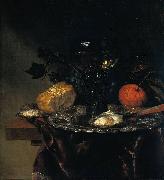 |
Abraham van Beijeren -- Click Here
|
|
(ca. 1620 - March 1690) was a Dutch Baroque era painter. He was little regarded in his day but is now considered one of the greatest of still-life painters. Van Beijeren (alternatively spelled "Beyeren") lived in a succession of Dutch towns. Born in The Hague, the artist also lived in Delft, Amsterdam, Alkmaar and Gouda. In 1678 he settled in Rotterdam, where he died in 1690.
|
|
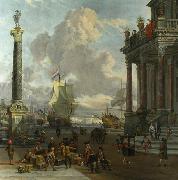 |
Abraham Storck -- Click Here
|
|
Abraham Storck (or Sturckenburch) (bapt. April 17, 1644 - buried April 8, 1708), was a Dutch landscape and maritime painter of the Baroque era.
Storck was born and died in Amsterdam, and came from a family of painters of the same name. He had a painter's studio in Amsterdam producing naval and harbor scenes as well as landscape paintings. He was influenced by the two Willem van de Veldes (the elder and the younger) and by Jan Abrahamsz Beerstraaten. |
|
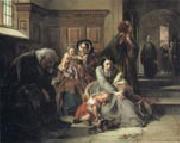 |
Abraham Solomon -- Click Here
|
|
English Painter, 1824-1862 |
|
|
|
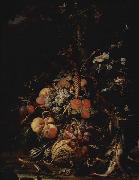 |
Abraham Mignon -- Click Here
|
|
(Frankfurt, June 21, 1640 - Utrecht, March 27, 1679), was a Dutch golden age painter, specialized in flower bouquets.
His father, a Frankfurt merchant, placed him under the care of the still-life painter Jacob Marrel, when he was only seven years old. Marrel specialized in flower painting, and found him to be his best pupil. He accompanied Mignon when he moved to the Netherlands about 1660 to work under Jan Davidszoon de Heem at Utrecht. In 1675 he settled there for good when he married the daughter of the painter Cornelis Willaerts (granddaughter of Adam Willaerts).
Marrel's stepdaughter Maria Sibylla Merian (1647-1717), daughter of the engraver Matthew Merian, who lived with Marrel and thus studied with Mignon, achieved distinction as a flower painter
|
|
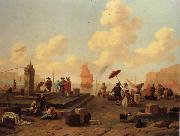 |
Abraham jansz.begeyn -- Click Here
|
|
Dutch painter and draughtsman , 1637-1697
was a Dutch painter of landscapes and cattle in the manner of Nicolaes Pietersz Berchem. Begeyn's earliest known work is from 1653. In 1655 he joined the painter's guild of Leiden, where he staid until at least 1667. He was then active in Amsterdam and The Hague, before he took his residence in Berlin in 1688. There his works were greatly prized, and, according to Houbraken, he was principal painter to Frederick III, the elector of Brandenburg, afterwards king of Prussia. In many collections in the Netherlands, the pictures of Begeyn are placed amongst those of the most admired masters. His pencilling is light and free, and his colouring very agreeable. Many of his works are landscapes, with views of rivers, ruins, and pieces of architecture, |
|
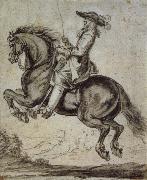 |
Abraham Jansz Van Diepenbeeck -- Click Here
|
|
1596-1675, Flemish glass-painter, draughtsman, painter and tapestry designer. His reputation rests primarily on his drawings and oil sketches, of which several hundred survive, intended mainly as designs for stained-glass windows and prints. He was strongly influenced by the work of other important Flemish artists of the late 16th century and early 17th, notably Rubens, whose motifs and stylistic elements he frequently reworked in his own compositions. |
|
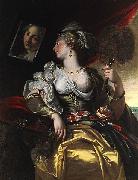 |
Abraham Janssens -- Click Here
|
|
van Nuyssen (ca. 1567/1576 - 1632) was a Flemish Baroque painter.
He was born at Antwerp, in a year variously reported between 1567 and 1576. He studied under Jan Snellinck, was a master in 1602, and in 1607 was dean of the master-painters. He died in the city of his birth.
Till the appearance of Rubens he was considered perhaps the best historical painter of his time. The styles of the two artists are not unalike. In correctness of drawing Janssens excelled his great contemporary; in bold composition and in treatment of the nude he equalled him; but in faculty of color and in general freedom of disposition and touch he fell far short. A master of chiaroscuro, he gratified his taste for strong contrasts of light and shade in his torchlights and similar effects. Good examples of this master are to be seen in the Antwerp museum and the Vienna gallery. The stories of his jealousy of Rubens and of his dissolute life are quite unfounded.
His students include Gerard Seghers and Theodoor Rombouts.
|
|
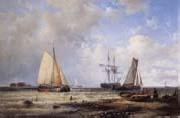 |
Abraham Hulk -- Click Here
|
|
1813-1897 Born in London, the senior member and best known of a family of painters, Abraham Hulk studied in Holland at the Amsterdam Academy under portrait painter Jean Augustin Daiwaille. |
|
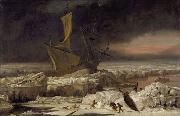 |
Abraham Hondius -- Click Here
|
|
(1625 - 1691) was a Dutch Golden Age painter known his depictions of animals. He was the son of a city stonemason, Daniel Abramsz de Hondt.
Hondius was born in Rotterdam and trained under Pieter de Bloot ( 1601 - 1658) and Cornelis Saftleven.He lived in Rotterdam until 1659 and moved then to Amsterdam. He moved to London] in 1666, where he spent the rest of his life. Hondius combined throughout his career several stylistic influences and struggled to develop a style of his own. He however specialised somehow in animal pieces: more than two-thirds of his paintings, etchings and drawings are hunting scenes, animals fighting and animal studies. He also executed landscapes, genre and religious scenes.
Hondius most likely moved to London] (where he later died) in 1666 where he spent the rest of his life. He painted views of London such as The Frost Fair on the Thames at Temple Stairs and London Bridge. His last known work is "Ape and Cat Fighting over Dead Poultry," dated 1690.
|
|
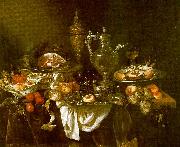 |
Abraham Hendrickz van Beyeren -- Click Here
|
|
1621-1690
Dutch
Abraham Hendrickz van Beyeren Location |
|
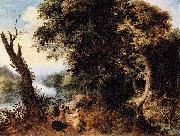 |
Abraham Govaerts -- Click Here
|
|
Abraham Govaerts (Antwerp, 1589 - 9 September 1626) was a Flemish Baroque painter who specialized in small cabinet-sized forest landscapes in the manner of Jan Brueghel the Elder and Gillis van Coninxloo.[1] He became a master in Antwerp's guild of St. Luke in 1607-1608, and subsequently trained several other painters in including Alexander Keirincx. Govaerts' paintings, such as A Forest View with the Sacrifice of Isaac (Alte Pinakothek, Munich), typically show diminutive history, mythological or biblical subjects within a Mannerist three-color universal landscape bracketed by repoussoir trees. The figures were often added by other artists, especially by members of the Francken family. |
|
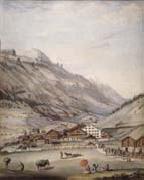 |
Abraham Fischer -- Click Here
|
|
1850 ?C 1913,was the sole Prime Minister of the Orange River Colony in South Africa. He was originally a lawyer in Cape Colony, joining the bar in 1875. He became vice-president of the Orange Free State's volksraad in 1893 and a member of the executive council in 1896. During the Boer War he went to Europe to solicit support for the Boers, returning in 1903 to practice law in the newly-formed Orange River Colony. Continuing to promote the Boer cause, he helped form the Oranje Unie party in May 1906 and became its chairman; the party won the majority of seats in the colony's first elections that were held in November 1907. On November 27, he was chosen as Prime Minister, and stayed in that position until it ceased to exist with the union of May 31, 1910. He then joined the cabinet of the Union of South Africa. |
|
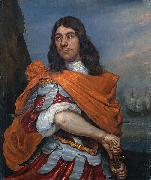 |
Abraham Evertsz. van Westerveld -- Click Here
|
|
painted Cornelis Tromp in Roman costume in 1650-1692 |
|
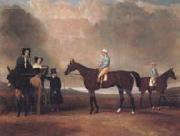 |
Abraham Cooper -- Click Here
|
|
British Painter, 1787-1868
English animal and battle painter, the son of a tobacconist, was born in London. At the age of thirteen he became an employee at Astley's Amphitheatre, and was afterwards groomed in the service of Sir Henry Meux. When he was twenty-two, wishing to possess a portrait of a favorite horse under his care, he bought a manual of painting, learned something of the use of oil-colours, and painted the picture on a canvas hung against the stable wall. His master bought it and encouraged him to continue in his efforts. He accordingly began to copy prints of horses, and was introduced to Benjamin Marshall, the animal painter, who took him into his studio, and seems to have introduced him to the Sporting Magazine, an illustrated periodical to which he was himself a contributor. In 1814 he exhibited his Tam O'Shanter, and in 1816 he won a prize for his Battle of Ligny. In 1817 he exhibited his Battle of Marston Moor and was made associate of the Academy, and in 1820 he was elected Academician. Cooper, although ill-educated, was a clever and conscientious artist; his coloring was somewhat flat and dead, but he was a master of equine portraiture and anatomy, and had some antiquarian knowledge. |
|
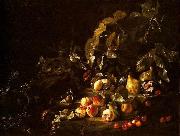 |
Abraham Brueghel -- Click Here
|
|
(1631-1690) was a Flemish painter from the famous family of artists. He was the son of Jan Brueghel the Younger, the grandson of Jan Brueghel the Elder and the great-grandson of Pieter Brueghel the Elder. |
|
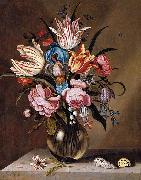 |
Abraham Bosschaert -- Click Here
|
|
(1612-1643) was a Dutch Golden Age painter.
Bosschaert was born in Middelburg. According to the RKD he was a member of the Bosschaert dynasty. Like his father Ambrosius Bosschaert and older brothers, he signed his works with a monogram; AB, but this was only discovered in 1992. His older brothers Ambrosius Bosschaert II and Johannes Bosschaert were his first teachers after the death of his father in 1623, but he also took lessons from his uncle Balthasar van der Ast in Utrecht from 1628-1637. In 1637 he moved to Amsterdam, but by 1643 he had returned to Utrecht, where he was buried on April 4th, 1643. |
|
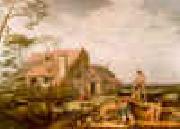 |
Abraham Bloemart -- Click Here
|
|
1564-1651
Dutch
Abraham Bloemart Locations |
|
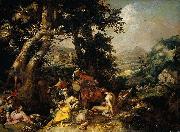 |
Abraham Bloemaert -- Click Here
|
|
(1566, Gorinchem - 27 January 1651, Utrecht), was a Dutch painter and printmaker in etching and engraving. He was one of the "Haarlem Mannerists" from about 1585, but in the new century altered his style to fit new Baroque trends.
Bloemaert was the son of an architect, who moved his family to Utrecht in 1575, where Abraham was first a pupil of Gerrit Splinter (pupil of Frans Floris) and of Joos de Beer. He then spent three years in Paris, studying under several masters, and on his return to his native country received further training from Hieronymus Francken. In 1591 he went to Amsterdam, and four years later settled finally at Utrecht, where he became dean of the Guild of St. Luke.
He excelled more as a colourist than as a draughtsman, was extremely productive, and painted and etched historical and allegorical pictures, landscapes, still-life, animal pictures and flower pieces. In the first decade of the seventeenth-century, Bloemaert began formulating his landscape paintings to include pictoresque ruined cottagges and other pastoral elements. In these works, the religious or mythological figures play a subordinate role. Country life was to remain Bloemaert's favourite subject, which he depicted with increasing naturalism. He drew motifs such as peasant cottages, dovecotes and trees from life and then on his return to the studio, worked them up into complex imaginary scenes.
Among his pupils are his four sons, Hendrick, Frederick, Cornelis, and Adriaan (all of whom achieved considerable reputation as painters or engravers), the two Honthorsts, Ferdinand Bol and Jacob Gerritsz Cuyp.
|
|
 |
Abraham Diepraam -- Click Here
|
|
1622-1670
Dutch
Abraham Diepraam Location |
|
 |
ABILDGAARD Nicolai -- Click Here
|
|
Nikolaj Abraham Abildgaard (September 11, 1743 - June 4, 1809), Danish artist, was born in Copenhagen, the son of Søren Abildgaard, an antiquarian draughtsman of repute, and Anne Margrethe Bastholm.
|
|
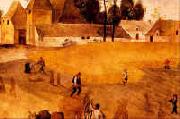 |
Abel Grimmer -- Click Here
|
|
Flemish Baroque Era Painter, ca.1570-C.1619 |
|
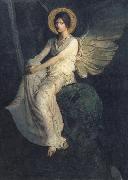 |
Abbott Handerson Thayer -- Click Here
|
|
American Painter, 1849-1921
American painter and naturalist. He spent his youth in rural New England, where his earliest paintings were wildlife subjects, reflecting his interest in hunting and fishing. While in his teens Thayer achieved some success doing portraits of family pets, which he continued after a move to New York. He attended classes at the Brooklyn Art School and National Academy of Design, but in 1875 he settled in Paris, studying under Henri Lehmann and Jean-L?on G?r?me at the Ecole des Beaux-Arts. While abroad he produced landscapes in the Barbizon style and genre scenes, but on his return to New York in 1879 |
|
|
|
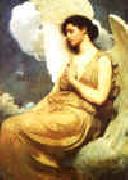 |
Abbot H Thayer -- Click Here
|
|
1849-1921
Abbot H Thayer Galleries
Abbott Handerson Thayer (August 12, 1849 ?C May 29, 1921) was an American artist, naturalist and teacher. As a painter of portraits, figures, animals and landscapes, he enjoyed a certain prominence during his lifetime, as shown by the fact that his paintings are in the most important U.S. art collections. In the last third of his life, he worked together with his son, Gerald Handerson Thayer, on a major book about protective coloration in nature, titled Concealing Coloration in the Animal Kingdom: An Exposition of the Laws of Disguise Through Color and Pattern; Being a Summary of Abbott H. Thayer??s Disclosures. First published by Macmillan in 1909, then reissued in 1918, it had a widespread impact on the use of military camouflage during World War I. He also influenced American art through his efforts as a teacher, taking on apprentices in his New Hampshire studio. |
|
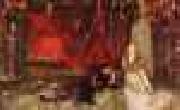 |
Abbey, Edwin Austin -- Click Here
|
|
American Golden Age Illustrator and Muralist, 1852-1911
American painter and illustrator, active in England. He began his artistic training in 1866, studying drawing with the Philadelphia portrait and landscape painter Isaac L. Williams (1817-95). In 1868 he attended evening classes in drawing at the Pennsylvania Academy of the Fine Arts under Christian Schussele (1824-79). In the same year Abbey began to work as an illustrator for the Philadelphia publishers Van Ingen & Snyder. In 1870 Harper's Weekly published the Puritans' First Thanksgiving, and in 1871 Abbey moved to New York to join the staff of Harper & Brothers, thus inaugurating his most important professional relationship. Throughout the 1870s Abbey's reputation grew, both for his detailed exhibition watercolours and for his elegant line drawings, which, translated to wood-engravings in numerous periodicals, illustrated both factual and fictional events of the past and present. The influences on him were mainly English, in particular the works of the Pre-Raphaelite Brotherhood and illustrations in the English press, which he studied avidly. The success of his illustrations to some of Robert Herrick's poems, such as Corinna's Going A-Maying in Harper's New Monthly Magazine (May 1874), prompted Harper & Brothers in 1878 to send Abbey to England to do a complete series of drawings for an illustrated gift-book, Selections from the Poetry of Robert Herrick (New York, 1882). |
|
|
|
|
| | |
|
|
|
|